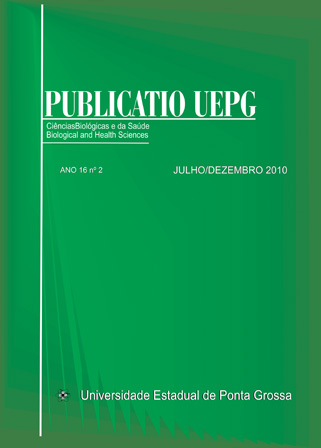MICROBIOLOGICAL QUALITY OF MEDICINAL PLANTS IN DOMESTIC GARDENS
DOI:
https://doi.org/10.5212/publicatio%20uepg.v16i2.3145Keywords:
Lasers. Infl ammation. Fibroblasts. Fibrocytes. Macrophages. Neutrophils. Collagen.Abstract
The aim of this study was to evaluate qualitatively and quantitatively the effect of two
lasers with different wavelengths in the infl ammatory process induced by surgical
wounds in the dorsal region of rats. For the study, 18 Rattus norvegicus male rats
weighing between 200 and 250g were used; each rat suffered a surgical incision of
0.5 cm in length. After the incision, Group I (n = 6) was subjected to irradiation with
a punctiform laser GaAs-Al ECCO ® fi bers (optical fi bers and devices Ecco Ltda.)
50mW of power, wavelength of 660 nm, distance 1cm and focal energy density 3J/
cm2. Group II (n = 6) was irradiated with GaAs VISION ® (Laser-und Medizin-
Technologie, Berlin) programmed for low-intensity laser therapy, power 4W/cm2,
980nn wavelength, focal length and density of 1cm 12J/cm2 of energy. The third
group was not irradiated after the surgical incision. The protocol for the application
of laser therapy was in surgery, 24 hours, 48 hours. The non-parametric Kruskal-
Wallis test was used for statistical analysis (p <0.05) comparing groups I, II and
III after 24 and 72 hours. The results showed a statistically signifi cant reduction
(p = 0.0236) in the number of macrophages in Group I in the 24-hour period. The
number of fi broblasts was signifi cant higher (p=0,0067) in Group III in the 24-hour
period. Group I presented a smaller amount of collagen type I signifi cantly lower
(p <0.001) than the other groups in the 24-hour period and, Group III showed a
signifi cant growth of these fi bers in relation to the other groups in the period of 72
hours (p <0.001). With respect to collagen type III, Group I showed a signifi cant
increase (p <0.001) compared with the other groups in the 24-hour period, but in
the 72-hour period, Group II showed a signifi cant greater amount (p <0.001). Low-
intensity laser therapy with both ! = 660nm and ! = 980nm showed macroscopic
and microscopic as well as qualitative and quantitative aspects that indicate the
attenuation of the infl ammatory process and the acceleration of the repair process
in this experimental model.
Downloads
Issue
Section
License

Este obra está licenciado com uma Licença Creative Commons Atribuição 4.0 Internacional.
Esta licença permite que outros distribuam, remixem, adaptem e criem a partir do seu trabalho, mesmo para fins comerciais, desde que lhe atribuam o devido crédito pela criação original. Este posicionamento está de acordo com as recomendações de acesso aberto da Budapest Open Access Initiative (BOAI).


